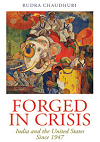The author’s assessment that India “was a nation persuaded by the uniqueness of its own imperatives” aptly captures the reason behind the often-fraught Indo-U.S. ties.
It has always been assumed that this sense of uniqueness stemmed from India’s colonial past and the ever-present fear of being treated as a “semi-colonial country”.
Soon after India gained independence, the first Prime Minister, Jawaharlal Nehru, refused to succumb to the exigency of much-needed food aid because of his insistence that he would only accept a deal “based on terms of mutual advantage”. The U.S. government found this baffling, given the dire urgency of the situation.
Questions regarding India’s conception of non-alignment and what it means – is it a post-Independence creed of semi-pacifism? Is it outdated? – continue to confound the world. But the concept lives on in the minds of Indians and is integral to the country’s DNA.
The author makes a concerted effort to demonstrate that the philosophy of non-alignment is neither anti-western, nor anti-American, nor, most importantly, is it a nebulous way of thinking. India’s continued refusal to align itself with either superpower in the era of the Cold War masks the fact that India sought both material and strategic interests and, importantly, achieved them.
What the book makes evident is that India repeatedly attained what it wanted from the U.S. without relinquishing its stance on non-alignment. The book concludes that India-U.S. relations have been erroneously characterised as “inherently fractious and necessarily in conflict”. The lengthy negotiations that led to the nuclear deal in 2008 are an example of how “officials on both sides managed to remain sure-footed but resilient”. This resiliency would not have been possible if it did not rest on “a degree of trust and a sense for each other”, which allowed for considerably more cooperation than what is commonly accepted.
India’s role in ending the war on the Korean Peninsula is little recognised and the author compels us to take a new and critical view of Nehru and India’s “approach to the U.S. during and after the Cold War”. Even Eisenhower, who had famously referred to the Indian elite as “funny people”, came to admire India.
The author compels us to re-assess India’s foreign policy positions, particularly in matters related to non-alignment, which thus far has been trapped in a staid reading that has suffered from `unsubstantiated conclusions‘.
Instead, non-alignment should be viewed as a `layered and introspective conception‘ under which Indian officials carved a `distinct persona for a nation unimpressed by dogmatic ideological policies underpinning containment during the Cold War‘.
We also need to study the past for it is only then that `the clear sense of direction that commentators strive for will become more obvious in the present, serving to guide Indian leaders as they seek to chart their nation’s future’.
The book offers several fresh perspectives. For example, he portrays Nehru as a true realist shattering the oft-held view that idealism informed India’s approach to the world. One school of thought maintains that non-alignment and the ambiguous language surrounding independence, autonomy and sovereignty was `nothing more than a disguise to strengthen external partnerships with the view to ensure (sic) economic and military assistance‘.
In the end, India got what it wanted – in late 1940; in 1962 after being defeated in the Chinese war; and most recently, in the early part of this century when India entered into a nuclear agreement on its terms and without signing the Nuclear Non-Proliferation Treaty.
The author pointedly states that India has been branded a `sovereignty hawk‘, and come to be seen as a troublemaker `relentlessly representing the virtue of dissent‘. President Obama learnt this lesson when the mere suggestion of U.S. intervention in the Kashmir dispute led to a stern rebuke. But the world welcomes India’s virtue of dissent because it represents and advocates `an alternative set of arguments … where the pursuit of foreign policy is increasingly challenged by opposition from within nation states themselves‘.
India will `never be an ally of the U.S.‘, the author concludes, but despite these attitudes, India and the U.S. need to, and will, engage on many matters of self-interest; India’s growing economy, strategic location, entrepreneurial spirit and its well established credentials as a democracy will continue to draw the U.S. which, despite setbacks, retains the ability to shape and inform world politics.
While demonstrating an understanding of and empathy with India’s position of dissent, the author advises India to do more to `articulate dissent‘ if it is to maintain a sense of international balance. His counsel to India is that `those producing the language for argument are inherently better placed to shape new grammar. Leadership requires a dictionary of its own.”
Perhaps those who have dealt with India across the negotiating table will take particular cheer from this piece of advice.
‘Forged in Crisis – India and the United States since 1947’. Rudra Chaudhuri, London: Hurst & Company, 2013.
Meera Kumar is a New York-based public relations professional. She has worked with the Asian Development Bank, the State University of New York, New York University, and several Fortune 20 companies. She started her career as a journalist writing for various media outlets in Southeast Asia, including the ‘Bangkok Post’ and ‘The Nation.’
This review was exclusively written for Gateway House: Indian Council on Global Relations. You can read more exclusive content here.
For interview requests with the author, or for permission to republish, please contact outreach@gatewayhouse.in.
© Copyright 2014 Gateway House: Indian Council on Global Relations. All rights reserved. Any unauthorized copying or reproduction is strictly prohibited.


